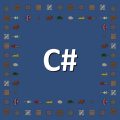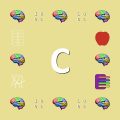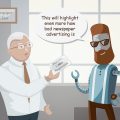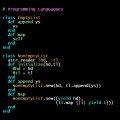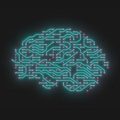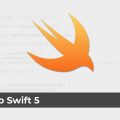
Coursera is one of the top course providers in the world and offers courses for various fields such as IT & Software, Business, Design, etc.
Coursera has a large number of courses, so it might be hard for anyone to choose the best course for them. For that reason, we have compiled the Top 20 Coursera Courses with regard to Software Development(Web Development, Data Science, Mobile Apps, etc.).
Project: Image Noise Reduction with Auto-encoders using TensorFlow
Amit Yadav
In this 2–hour long project-based course, you will learn the basics of image noise reduction with autoencoders. Auto–encoding is an algorithm to help reduce the dimensionality of data with the help of neural networks. It can be used for lossy data compression where the compression is dependent on the given data.
★★★★★(5-star rating)
Project: Image Classification with CNNs using Keras
Amit Yadav
In this 1–hour long project-based course, you will learn how to create a Convolutional Neural Network (CNN) in Keras with a TensorFlow backend, and you will learn to train CNNs to solve Image Classification problems. In this project, we will create and train a CNN model on a subset of the popular CIFAR–10 dataset.
★★★★★(5-star rating)
Social Network Analysis(Free)
Martin Hilbert
This course is designed to quite literally ’make a science’ out of something at the heart of society: social networks. Humans are natural network scientists, as we compute new network configurations all the time, almost unaware when thinking about friends and family (which are particular forms of social networks), about colleagues and organizational relations (other, overlapping network structures), and about how to navigate delicate or opportunistic network configurations to save guard or advance in our social standing (with society being one big social network itself).
★★★★★(5-star rating)
Project: Perform Sentiment Analysis with scikit-learn
Snehan Kekre
This course is designed to quite literally ’make a science’ out of something at the heart of society: social networks. Humans are natural network scientists, as we compute new network configurations all the time, almost unaware when thinking about friends and family (which are particular forms of social networks), about colleagues and organizational relations (other, overlapping network structures), and about how to navigate delicate or opportunistic network configurations to save guard or advance in our social standing (with society being one big social network itself).
★★★★★(5-star rating)
Computer Simulations(Free)
Martin Hibert
Big data and artificial intelligence get most of the press about computational social science, but maybe the most complex aspect of it refers to using computational tools to explore and develop social science theory. This course shows how computer simulations are being used to explore the realm of what is theoretically possible. Computer simulations allow us to study why societies are the way they are, and to dream about the world we would like to live in.
★★★★★(5-star rating)
Computational Social Science Methods(Free)
Martin Hibert
This course gives you an overview of the current opportunities and the omnipresent reach of computational social science. The results are all around us, every day, reaching from the services provided by the world’s most valuable companies, over the hidden influence of governmental agencies, to the power of social and political movements. All of them study human behavior in order to shape it.
★★★★★(5-star rating)
Data Analysis and Representation, Selection and Iteration(Free)
Dr. Tim “Dr. T” Chamillard
This course is the second course in the specialization exploring both computational thinking and beginning C programming. Rather than trying to define computational thinking, we’ll just say it’s a problem–solving process that includes lots of different components.
★★★★★(5-star rating)
C# Programming for Unity Game Development Capstone Project(Free)
Dr. Tim “Dr. T” Chamillard
This course is the second course in the specialization exploring both computational thinking and beginning C programming. Rather than trying to define computational thinking, we’ll just say it’s a problem–solving process that includes lots of different components.
★★★★★(5-star rating)
Abstraction, Problem Decomposition, and Functions(Free)
Dr. Tim “Dr. T” Chamillard
This course is the third course in the specialization exploring both computational thinking and beginning C programming. Rather than trying to define computational thinking, we’ll just say it’s a problem–solving process that includes lots of different components.
★★★★★(5-star rating)
Project: Multiple Linear Regression with scikit-learn
Snehan Kekre
In this 2–hour long project-based course, you will build and evaluate multiple linear regression models using Python. You will use scikit–learn to calculate the regression, while using pandas for data management and seaborn for data visualization. The data for this project consists of the very popular Advertising dataset to predict sales revenue based on advertising spending through media such as TV, radio, and newspaper.
★★★★★(5-star rating)
Geometric Algorithms(Free)
Kevin Buchin
Course Information: In many areas of computer science such as robotics, computer graphics, virtual reality, and geographic information systems, it is necessary to store, analyze, and create or manipulate spatial data. This course deals with the algorithmic aspects of these tasks: we study the techniques and concepts needed for the design and analysis of geometric algorithms and data structures.
★★★★★(5-star rating)
Programming Languages, Part C(Free)
Dan Grossman
This course is an introduction to the basic concepts of programming languages, with a strong emphasis on functional programming. The course uses the languages ML, Racket, and Ruby as vehicles for teaching the concepts, but the real intent is to teach enough about how any language “fits together” to make you more effective programming in any language and in learning new ones.
★★★★★(5-star rating)
Advanced Deployment Scenarios with TensorFlow(Free)
Laurence Moroney
Bringing a machine learning model into the real world involves a lot more than just modeling. This Specialization will teach you how to navigate various deployment scenarios and use data more effectively to train your model. In this final course, you’ll explore four different scenarios you’ll encounter when deploying models.
★★★★★(5-star rating)
Networks: Friends, Money, and Bytes
Mung Chiang
You pick up your iPhone while waiting in line at a coffee shop. You google a not–so–famous actor, get linked to a Wikipedia entry listing his recent movies and popular YouTube clips of several of them. You check out user reviews on Amazon and pick one, download that movie on BitTorrent or stream that in Netflix.
★★★★★(5-star rating)
Data Analytics Foundations for Accountancy II(Free)
Robert Brunner
Welcome to Data Analytics Foundations for Accountancy II! I’m excited to have you in the class and look forward to your contributions to the learning community. To begin, I recommend taking a few minutes to explore the course site. Review the material we’ll cover each week, and preview the assignments you’ll need to complete to pass the course. Click Discussions to see forums where you can discuss the course material with fellow students taking the class.
★★★★★(5-star rating)
Creating Cutscenes in Unity(Free)
Joy Horvath
Welcome to Creating Cutscenes in Unity, the fifth course in the Unity Certified 3D Artist Specialization from Unity Technologies. The courses in this series will help you prepare for the Unity Certified 3D Artist exam, the professional certification for entry– to mid–level Unity artists. 3D artists are critical to the Unity development pipeline.
★★★★★(5-star rating)
Advanced Linear Models for Data Science 2: Statistical Linear Models(Free)
Brian Caffo, PhD
Welcome to the Advanced Linear Models for Data Science Class 2: Statistical Linear Models. This class is an introduction to least squares from a linear algebraic and mathematical perspective. Before beginning the class make sure that you have the following: – A basic understanding of linear algebra and multivariate calculus.
★★★★★(5-star rating)
AI Workflow: Machine Learning, Visual Recognition and NLP(Free)
Mark J Grover
This is the fourth course in the IBM AI Enterprise Workflow Certification specialization. You are STRONGLY encouraged to complete these courses in order as they are not individual independent courses, but part of a workflow where each course builds on the previous ones. Course 4 covers the next stage of the workflow, setting up models and their associated data pipelines for a hypothetical streaming media company.
★★★★★(5-star rating)
iOS Project: Transreality Game(Free)
Don Patterson
Students will produce a networked game that will leverage sensors on the phone to create a unique gaming experience. The focus of the game will be to make it physical through real–world gestures, motion and knowledge of other players real–world location. To do this students will need to integrate knowledge of graphics, networking, sensors, and user interface design alongside a skill set of tool usage.
★★★★★(5-star rating)
iOS App Store & In-App Purchases(Free)
Mark Price
This course teaches basics of monetization on iOS, starting with in–app ads and then moving to in–app purchases. You will learn more advanced in–app purchase integrations, and you’ll make both consumable and non–consumable purchases while building a realistic iOS app. Finally, you will learn how to take your apps even further with in–app subscriptions, and how to start and cancel subscriptions and create a delightful user experience.
★★★★★(5-star rating)








